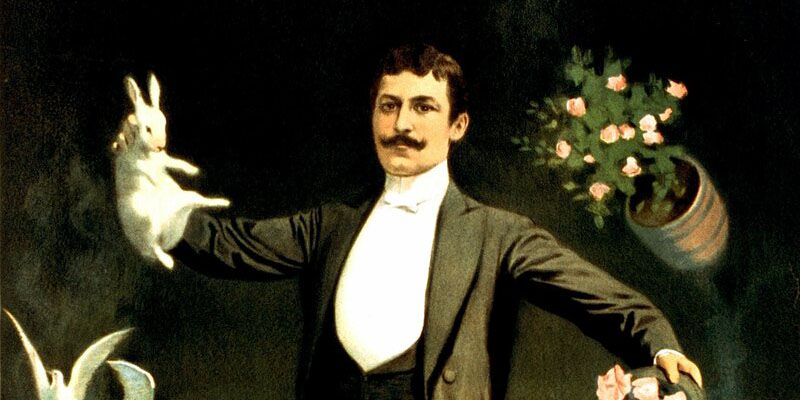Midway through a three-minute magic trick, Teller, of the famed duo Penn & Teller, appears frustrated and confused.
A minute earlier he made dozens of coins appear — seemingly out of thin air — and dropped them into the fishbowl sitting on an audience member’s lap. When he then empties the coin-filled bowl into a water tank, he’s clearly expecting something to happen. So is the audience, and then … nothing.
Teller, seemingly befuddled, returns to the audience participant and fiddles with the fishbowl again. Finally, he goes back to the water basin and, this time, turns the coins into goldfish.
It’s a beautiful, almost lyrical illusion. It’s also a reminder of the job of the magician — to lie. Teller knew his trick hadn’t failed, yet he led the audience to believe it had. It’s an illusion on top of an illusion.
“Being a magician is the only job where someone will come up to you and say, ‘Please trick me. Please lie to me,’” Ian Frisch, author of Magic is Dead: My Journey into the World’s Most Secretive Society of Magicians, told me.
And, yet, we often see stage magicians serving as detectives — people entrusted with uncovering the truth — in mysteries dating back to the Golden Age. This spring, the second installment in two new series starring illusionists, The Raven Thief by Gigi Pandian and Tom Mead’s The Murder Wheel, will continue to build on this tradition, showing that sometimes it takes a liar to spot the truth.
Who Better to Solve an Impossible Crime?
Stage magicians — as sleuths, victims or side characters — were common features of Golden Age detective stories. Clayton Rawson, an amateur magician himself, created the characters of the Great Merlini and Don Diavolo, both illusionists who use their knowledge of trickery and stage craft to solve crimes. G.T Fleming-Roberts, a prolific pulp writer, wrote stories about Diamondstone: Magician-Sleuth. Walter Gibson wrote a series of short stories about Norgil the Magician. Others, such as John Dickson Carr, feature conjurers as victims, suspects or witnesses to crimes.
The popularity of the magician-detective during the Golden Age mirrors the period’s obsession with the locked room or impossible crime mystery, where the murderer has vanished from a room with no available exists or a culprit seemingly disappears in front of a crowd.
The parallel rise makes intuitive sense: Who better to solve an impossible crime than someone who performs escapes and makes things disappear? Rawson’s first Merlini book even makes this connection explicit, quoting the “locked room lecture” Carr’s reoccurring detective Gideon Fell makes in The Hollow Man.
The trope of magician as detective has had a bit of a comeback in recent years. Besides Mead and Pandian’s books, there’s John Gaspard’s Eli Marks about a stage performer with a homicide detective ex-wife who keeps stumbling over dead bodies. In The Stephens and Mephisto books by Elly Griffiths, a detective inspector and his magician friend team up to solve murders in 1950s England. Andrew Mayne has featured illusionist-turned-FBI-agent Jessica Blackwood in two of his series. ABC even briefly got in on the action with a short-lived show, “Deception,” about a magician who joins the FBI.
“I came to love stage magic through mystery novels because during the Golden Age of detective fiction it was much more common for there to be magician-sleuths or magician-characters creating misdirection. I’m so happy there’s a mini resurgence right now,” Pandian said.
The Setup and the Story
Pandian enlisted friends in southern California to help her perform a mentalism act while on tour for Under Lock and Skeleton Key, the first book in her series featuring former Las Vegas illusionist Tempest Raj. Still, she doesn’t want to know too much about how tricks are performed.
In Under Lock and Skeleton Key, Tempest shares how she solved the murder and offers hints to how she performs an illusion, but she and her friend The Hindi Houdini keep secrets to themselves.
“With modern stage magic even though you can go online and learn how any trick was done, it’s not the mechanism of a trick that makes magic magical. It’s the setup and the way the story unfolds,” Pandian said.
The same is true about reading mysteries featuring an illusionist — the stakes, the misdirection, the ultimate reveal. Writing a tightly plotted mystery and pulling off a fantastic magic trick takes the same skills and ability.
“The process is ultimately the same in that you are, as an author, sending them in the wrong direction,” Mead said. “You’re literally misdirecting them the same way a magician does by sleight of hand. You’re doing it with language by placing the clues in such a way that they are hidden within the narrative.”
Frisch, a journalist and magician, who hasn’t written a mystery, sees the similarities as well.
“Benoit Blanc in ‘Knives Out,’ thinks like a magician. That’s where that crossover is, is that a great sleuth, understands the human mind,” he said.

















